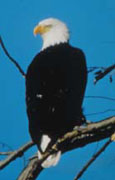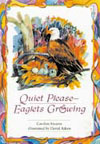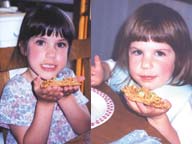 |
| Photo courtesy of Maryland Department of Natural Resources |
Quiet Please — Eaglets Growing
By Martha Blume
Want to learn more about what makes our national bird worth saving? Read Carolyn Stearn’s new picture book, Quiet Please — Eaglets Growing (Tidewater Publishers, 2002).
John-B, the book’s hero, discovers a pair of nesting bald eagles in an oak tree next to his school on the Western Shore of the Chesapeake. When his teacher announces that Sunset Corporation plans to cut down the trees to build condominiums, the fifth grader organizes his class and community to save the eagles.
The students learn that the survival of the eagles’ habitat depends on the pair raising eaglets. The community waits in anxious hope that the female will lay eggs. When she does, and it becomes clear that even this won’t protect the eagles’ long-term interests, the community goes one step further. They hire a lawyer to stop the developers from destroying the eagles’ habitat.
If only real life were like this. Sometimes it is. In Deale two years ago, local activists discovered a pair of eagles nesting in a site slated for development and brought enough public attention to the issue to force the developers to change their plans.
 Stearn’s book reads more like non-fiction than a picture book. Chock full of facts about the natural history of eagles, it outlines a great plan for protecting threatened species that activists of any age can follow.
Stearn’s book reads more like non-fiction than a picture book. Chock full of facts about the natural history of eagles, it outlines a great plan for protecting threatened species that activists of any age can follow.
David Aiken’s watercolor pictures of the mature eagles and their downy chicks beautifully illustrate the eagles’ life history.
Also by Carolyn Stearns: Where Did All the Water Go? (Tidewater, 1998)
How big is an eagle’s nest?
It’s really hard to imagine. Bald eagles build the largest nests of any pair of birds in the world. Go out to your backyard. Start collecting sticks and piling them together to make a circle seven feet across. Now pile the sticks high until they reach the second floor of your house. Get the idea? Give up yet? After you build your nest, line it with moss, pine needles, grass or feathers. Now hoist it up to the top of your tallest tree. Maybe an eagle will come!
 |
| Margaret and Phoebe Blume show off their edible eagle nests. |
Make an eagles’ nest you can eat
Eagles generally lay two off-white eggs in their nests made of sticks. To make your own edible eagles nests, you need: two and one-half cups of chow mein noodles, three-fourths cup of peanut butter, one-half cup of chocolate chips, malted milk balls.
Melt and stir the peanut butter and chocolate chips in a heavy pan over low heat. When they are melted, remove from heat and stir in the chow mein noodles. Line a pan with waxed paper. On the waxed paper, shape the noodle mixture into about five nests. Careful, it will be hot. Place the nests in the freezer for half an hour. Remove and add two white malted milk balls to each nest. Enjoy.
Kids Stuff
Friday, November 22
Sleeping Bears
Learn all bout how and why bears hibernate while reading the story Bear Snores On, by Karma Wilson. Join other curious kids for this enlightening story hour. 10am @ Barnes & Noble, Annapolis. Free; rsvp: 410/573-1115.
Saturday, November 23
Ruby’s Journey
Follow Ruby, the ruby-throated hummingbird, on her long perilous journey to Central America meeting the friends she makes along the way in this interactive puppet program. 1am and 1:30pm @ National Wildlife Visitor Center, Laurel. Free; rsvp: 301/497-5887.
Kids & Critters
Join a naturalist to learn about habitats, including if animals and people need the same things to survive. For ages 3-5. 10am @ Battle Creek Cypress Swamp. $3; rsvp: 410/535-5327.
Make a Wreath
Get into the holiday spirit with Ranger Bob Hicks as you make a beautiful all-natural holiday wreath for our fine-feathered friends. For ages 8-14. 10am @ Kinder Farm Park, Millersville. $5; rsvp: 410/222-6115.
Birding Basics
If you are 16 or older you, can go learn about bird identification, habitats and equipment. Binoculars and field guides recommended.1pm @ National Wildlife Visitor Center, Laurel. Free; rsvp: 301/497-5887.